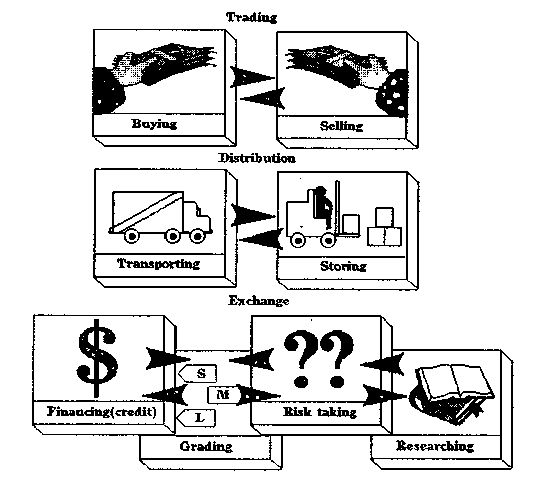
- •Challenges in Marketing
- •Ббк 81.2Англ-923
- •Ббк 81.2Англ-923
- •Contents
- •Передмова
- •Part I Unit 1 The Marketing Mix (The 4 p's)
- •The product life cycle.
- •Commentary
- •Business Stages in Marketing
- •Grammar point Modal Verbs Expressing Ability and Possibility
- •Unit 2 The Promotion Mix
- •Commentary
- •Business Branding
- •Grammar point Modal Verbs Expressing Request, Offer, Suggestion, Asking for Permission and Instructions
- •Grammar point Modal Verbs Expressing Supposition
- •Unit 3 How Markets Work
- •Commentary
- •Business The New Marketplace
- •Part II Texts for Supplementary reading
- •Text 1: what do marketers do?
- •Text 2. The marketing communication function
- •Text 3: the market segmentation function
- •Text 4: marketing research
- •Text 5: focus group studies
- •Text 6: survey research
- •Product development
- •Text 1: product importance
- •Text 2: what is a product?
- •Text 3: different product views
- •Text 4: the product mix
- •Text 5: marketing different classes of consumer goods
- •Text 6: marketing industrial products
- •Text 7: packaging changes the product
- •Text 8: the growing importance of packaging
- •Text 9: different packaging functions
- •Text 10: branding
- •Text 11: brand categories
- •Promotion
- •Text 1: communication versus promotion
- •Text 2: marketing communication system (mcs)
- •Text 3: marketing intelligence versus marketing research
- •Text 4: promotion
- •Text 5: advertising
- •Text 6: classes of advertising
- •Text 7: sales promotion
- •Answers Test 1
- •Challenges in Marketing
- •83050, М.Донецьк, вул.Щорса, 31.
- •83023, М.Донецьк, вул.Харитонова, 10.
Text 1: what do marketers do?
The problem was getting goods from the producer to the consumer. The most basic need was for food, so marketers concentrated on the transportation and storage of food products. Manufacturers needed raw materials to produce various products, so the distribution of industrial goods (coal steel, wood) was also important.
By the 1920 marketers were described as performing eight basic functions (See Figure 1:
-
Buying
-
Selling
-
Transporting
-
Storing
-
Financing
-
Standardizing
-
Risk taking
-
Research
By the 1980s, new consumer demands had changed what marketers had to do. Rather than focus on functions such as distribution and storage, marketers shifted their attention to more careful listening to consumers (communication), and more attention was given to identifying specific markets (segmentation). Now more attention is being placed on two others: marketing communication and market segmentation.

Figure 1. Eight basic marketing functions by category.
Buying and selling (trading) are the heart of the marketing. But buying and selling do not take place unless goods are transported to where they are wanted and stored there until buyers are ready to buy (distribution). Who can afford to buy a house or car without financing? Because credit was so critical to selling, it was a major marketing function at first. Now it is more a finance function. Storing goods meant taking a risk of theft, damage or obsolescence. Thus marketers assumed the function of taking those risks (and buying insurance). Marketing of farm products and commodities (for example, steel) demanded standardization and grading of goods. Finally, the whole process begins and ends with researching the market to find wants and needs and then testing to see if needs are being satisfied.
Text 2. The marketing communication function
Marketing communication involves talking with consumers to be sure the product, price and all other aspects of the trade relationship are what is wanted. It is an ongoing process. A classic explanation of the process was given by John Marder of Grey Advertising. This is what he said:
In the beginning there is a seller and there is a buyer. And if they are to interact... they must communicate with one another. And in fact they do ... in a variety of ways. Typically, the buyer communicates with the seller through the answers he gives to the seller's market research. And the seller, in turn, communicates with the buyer through his advertising.
In greater detail ... their communications go like this:
-
The buyer express his wants and needs, his desires and satisfactions.
-
The seller, sensing the opportunity for profit makes the product or service that is called for.
-
Then, through his advertising the seller tells the buyer that he has just the thing the buyer was asking for.
-
And if the seller has correctly understood what the buyer was saying ... and if he has actually made what was asked of him ... the buyer will probably buy.
Buying and selling (trading) are the heart of the marketing. But buying and selling don't take place unless goods are transported to where they are wanted and stored there until buyers are ready to buy (distribution). Who can afford to buy a house or a car without financing? Because credit was so critical to selling, it was a major marketing function at first. Now it is more a finance function. Storing goods meant taking the risk of theft, damage or obsolescence. Thus marketers assumed the function of taking those risks (and buying insurance). Marketing of farm products and commodities (for example, steel) demanded standardization and grading of goods. Finally, the whole process begins and ends with researching the market to find wants and needs and then testing to see if needs are being satisfied.
